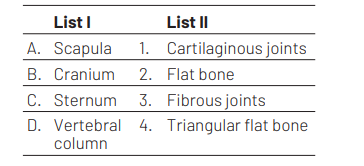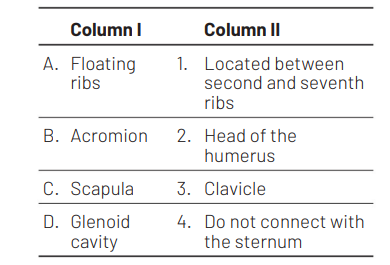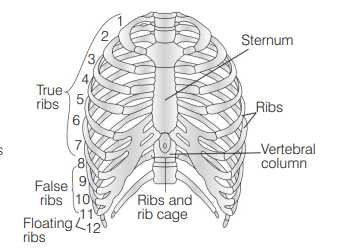Question
Match the List I with List II.[NEET 2021]

Choose the correct answer from the options given below.
A B C D
(a) 1 3 2 4
(b) 2 3 4 1
(c) 4 2 3 1
(d) 4 3 2 1
Answer/Explanation
Ans. (d)
(A)-(4), (B)-(3), (C)-(2), (D)-(1)
Scapula It is a flat, triangular shaped bone. It is located at the upper thoracic region on the dorsal surface of the ribcage. Cranium It is the part of the skull that encloses the brain. They have immovable fibrous joint. Sternum It is the flat bone located in the middle of chest. Also referred as breastbone. Vertebral column It is a series of approximately 33 bones called vertebrae. They have cartilaginous type joints designed for weight bearing.
Question
Select the incorrectly matched pair from following. [NEET (Oct.) 2020]
(a) Chondrocytes-Smooth muscle cells
(b) Neurons-Nerve cells
(c) Fibroblast-Areolar tissue
(d) Osteocytes-Bone cells
Answer/Explanation
Ans. (a)
The incorrectly match pair is option (a). It can be corrected as
Chondrocytes are cartilage cells. The intercellular material of cartilage is solid, pliable and resists compression. Cells of this tissue are called chondrocytes which are enclosed in small cavities within the matrix secreted by them.
Question
Match the following columns and select the correct option. [NEET (Sep.) 2020]

A B C D
(a) 1 3 2 4
(b) 3 2 4 1
(c) 4 3 1 2
(d) 2 4 1 3
Answer/Explanation
Ans. (c)
The correct option is (c). It can be explaed as follows
11th and 12th pairs of ribs are not connected ventrally with sternum and are therefore, called floating ribs.
Acromion is a flat expanded process of spine of scapula. The lateral end of clavicle articulates with acromion process. Scapula is a flat triangular bone in the dorsal part of the thorax between 2nd and the 7th rib. Glenoid cavity of scapula articulates with head of the humerus to form the shoulder joint.
Question
Select the correct option. [NEET (National) 2019]
(a) 11th and 12th pairs of ribs are connected to the sternum with the help of hyaline cartilage
(b) Each rib is a flat thin bone and all the ribs are connected dorsally to the thoracic vertebrae and ventrally to the sternum
(c) There are seven pairs of vertebrosternal, three pairs of vertebrochondral and two pairs of vertebral ribs
(d) 8th, 9th and 10th pairs of ribs articulate directly with the sternum
Answer/Explanation
Ans. (c)
The statement that there are seven pairs of vertebrosternal, three pairs of vertebrochondral and two pairs of vertebral ribs is correct.
Rest statements are incorrect. Correct information about the statements is as follows Vertebrosternal ribs are first seven pairs of true ribs which are attached dorsally to thoracic vertebrae and ventrally to the sternum.
Vertebrochondral ribs (8th, 9th, 10th pairs) are false ribs which are not attached to sternum directly. They are attached to the seventh rib with the help of hyaline cartilage.
Vertebral ribs are the last two pairs of floating ribs which are attached to vertebrae dorsally and are not attached ventrally.
Question
Out of ‘ $X$ ‘ pairs of ribs in humans only ${ }^{\prime}$ ‘ pairs are true ribs. Select the option that correctly represents values of $X$ and $Y$ and provides their explanation.
[NEET 2017]
(a) $X=12, Y=7 \quad$ True ribsare attached dorsally to vertebral column and ventrally to the sternum.
(b) $X=12, Y=5$ True ribsare attached dorsally to vertebral column and sternum on the two ends.
(c) $X=24, Y=7$ True ribs are dorsally attached to vertebral column, but are free on ventral side.
(d) $X=24, Y=12$ True ribs are dorsally attached to vertebral column, but are free on ventral side.
Answer/Explanation
Ans. (a)
In the rib cage, the true ribs are those which are attached to the sternum in the front and vertebral column at back. These are 7 in numbers. Although there are total 12 ribs in the rib cage. The 11th and 12th ribs are attached to the vertebral column and keep floating in the thoracic cavity, so are called floating ribs.

Question
Which of the following is not a function of the skeletal system? [CBSE AIPMT 2015]
(a) Production of erythrocytes
(b) Storage of minerals
(c) Production of body heat
(d) Locomotion
Answer/Explanation
Ans. (c)
Production of body heat is the function of muscles. The contraction of muscle produce heat, which keeps the body warm during the winters.
Question
An acromion process is characteristically found in the [CBSE AIPMT 2005]
(a) pelvic girdle of mammals
(b) pectoral girdle of mammals
(c) skull of frog
(d) sperm of mammals
Answer/Explanation
Ans. (b)
An acromion process is found in pectoral girdle of mammals. Pectoral girdle consists of scapula and clavicle. The scapula consists of a sharp ridge, the spine and a triangular body. The end of the spine projects as a flattened and expanded process called acromion.
Question
What will happen if ligaments are cut or broken? [CBSE AIPMT 2002]
(a) Bones will move freely at joints
(b) No movement at joint
(c) Bone will become unfix
(d) Bone will become fixed
Answer/Explanation
Ans. (c)
Ligaments are specialised connective tissues which connect bones together; hence, if they are cut or broken the bone will become unfixed.
Question
Which one of the following is a skull bone? [CBSE AIPMT 2000]
(a)Atlas
(b) Coracoid
(c) Arytenoid
(d) Pterygoid
Answer/Explanation
Ans. (d)
Pterygoid is a small bone articulated with the palatine. In human it becomes the pterygoid processes of the sphenoid bone.
Question
Ligament is a [CBSE AIPMT 1999]
(a) modified yellow elastic fibrous tissue
(b) inelastic white fibrous tissue
(c) modified white fibrous tissue
(d) None of the above
Answer/Explanation
Ans. (b)
Ligaments are made up of inelastic white fibrous tissue and connect bones at joints. It is also known as articular ligament, articular larua or fibrous ligament.
Question
Tendon is made up of [CBSE AIPMT 1999]
(a) adipose tissue
(b) modified white fibrous tissue
(c)areolar tissue
(d) yellow fibrous connective tissue
Answer/Explanation
Ans. (b)
The modified white fibres tissue form cords called tendons which connect muscles with the bones.
Question
Total number of bones in the hind limb of man is [CBSE AIPMT 1998]
(a) 14
(b) 30
(c) 24
(d) 21
Answer/Explanation
Ans. (b)
1 femur $+1$ fibula + 1 tibia $+1$ patella $+7$ tarsals $+5$ meta tarsals $+14$ phalanges
make one hind limb of man. Total of 30 bones.
Question
The lower jaw in mammals is made up of [CBSE AIPMT 1998]
(a) mandible
(b) dentary
(c) maxilla
(d) angulars
Answer/Explanation
Ans. (b)
Dentary is tooth bearing membrane bone of lower jaw of the vertebrates-one on each side.
Question
The number of floating ribs, in the human body, is [CBSE AIPMT 1995]
(a) 6 pairs
(b) 5 pairs
(c) 3 pairs
(d) 2 pairs
Answer/Explanation
Ans. (d)
Usually, there are 12 pairs of ribs, but occasionally these may be 11,13 or even 14 pairs. The first seven pairs of ribs are known as true ribs.
Pairs 8, 9,10 are false ribs, they are attached indirectly to sternum by means of cartilages. Last two pairs (11 and 12) do not reach to the sternum and are known as floating ribs’.
Question
Which is a part of pectoral girdle? [CBSE AIPMT 1994]
(a) Glenoid cavity
(b) Sternum
(c) lleum
(d) Acetabulum
Answer/Explanation
Ans. (a)
A cavity known as glenoid cavity is present at the tip of scapula and coracoid process, for articulation of head of humerus. Pectoral girdle consists of a membranous bone called clavicle and a large replacing bone called shoulder blade or scapula coracoid.
Question
Long bones function in [CBSE AIPMT 1993]
(a) support
(b) support, erythrocyte and leucocyte synthesis
(c) support and erythrocyte synthesis
(d) erythrocyte formation
Answer/Explanation
Ans. (b)
In higher animals, movements and locomotion depend on the association of skeletal muscles and skeletal system (bones and joints). Bones function to provide support as well as produce erythrocytes and leucocytes in the bone marrow.
Question
A deltoid ridge occurs in [CBSE AIPMT 1990]
(a) radius
(b) ulna
(c) femur
(d) humerus
Answer/Explanation
Ans. (d)
Humerus is the bone of forelimb. It bears head, greater tuberosity and lesser tuberosity. Proximal part of humerus bears a slight ridge, which is called as deltoid ridge.
Question
Number of cervical vertebrae in camel is [CBSE AIPMT 1990]
(a) more than that of rabbit.
(b) less than that of rabbit
(c)same as that of whale
(d) more than that of horse
Answer/Explanation
Ans. (c)
Cervical vertebrae are seven in number, constant in most of the mammals.
Whale, camel, giraffe, etc. have same number of cervical vertebrae. However, long neck in camel and giraffe is due to more length of vertebrae.
Question
Extremities of long bones possess cartilage [CBSE AIPMT 1989]
(a) calcified
(b) fibrous
(c) elastic
(d) hyaline
Answer/Explanation
Ans. (d)
Hyaline cartilage is the most abundant cartilage. It forms the cushions or pads upon the articular surfaces at joints of long bones, known as articular cartilage. It forms the costal cartilage at the ventral ends of ribs, and also helps to form the nose, larynx, trachea, bronchi and bronchial tubes.
